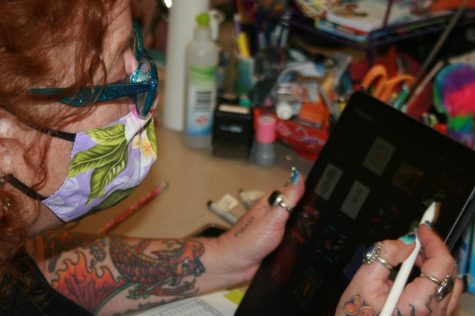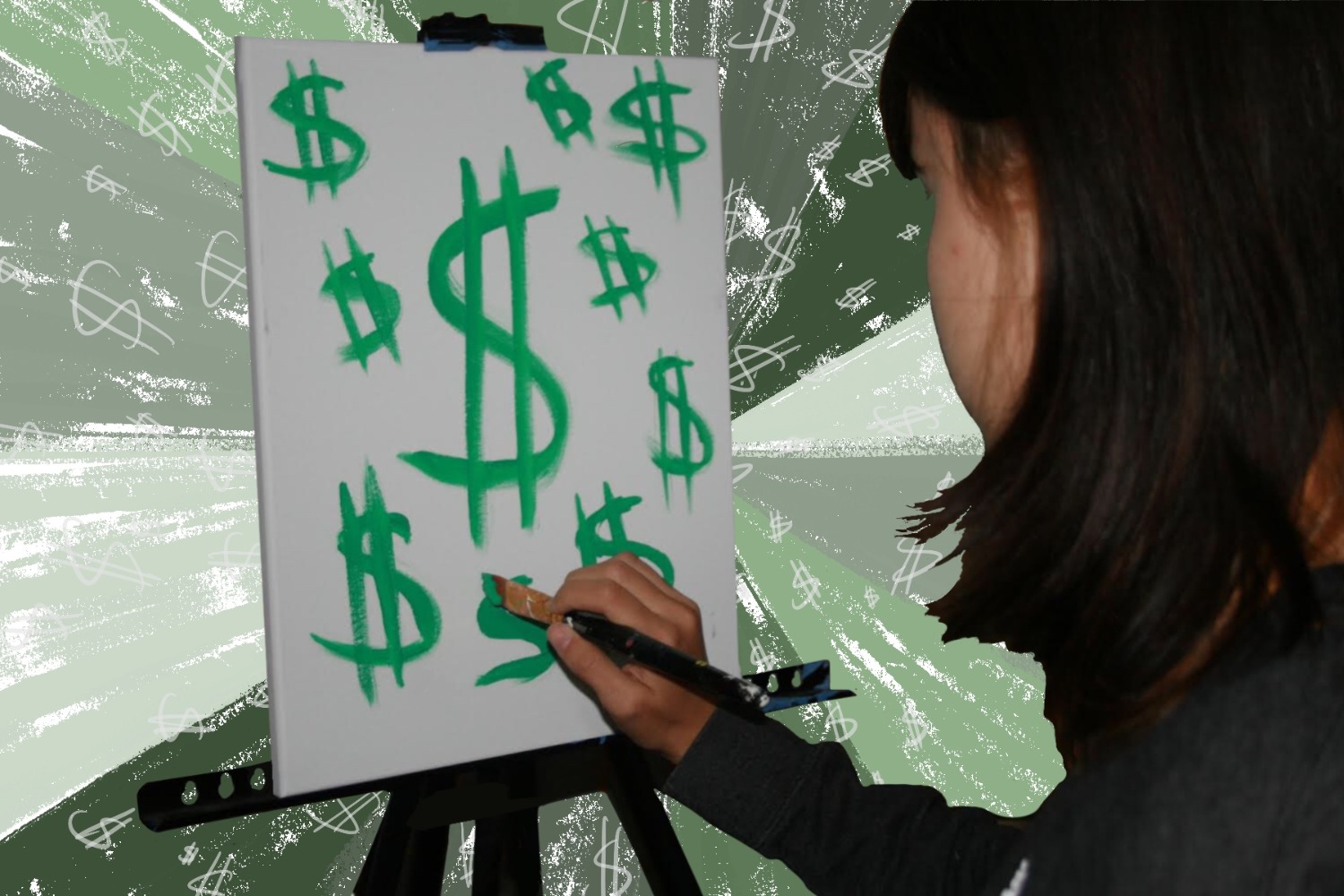When a child announces their interest in anything artistic, parents begin picturing their adolescent broke and alone, painting in an attic while desperately in search of their next paycheck.
People are products of their culture and hold their own perceptions of the ideal career paths for their children. Some parents map out their child’s life by expecting them to pursue occupations in engineering, law, or medicine because they view them to provide a concrete salary. Artistic endeavors, in contrast, are stereotypically seen as low-income professions.
But art processes are constantly building upon themselves and technological developments have created new forms of digital art and careers. An interest in art and creative visuals can be applied to higher-paying art fields including art directing, graphic designing, art curating, and interior design. Though these occupations may not pay as much when compared to their STEM counterparts, they allow those who pursue them to do what they enjoy while earning a comfortable income.
Careers
The contemporary world has adopted an increasingly visual culture, one dependent on design to add color and life to the technology we use.
Creative ideas in art and design have been instrumental in the successes of many industries and continue to shape them today.
Design is integrated into our phones, and large technology companies such as Apple pay their graphic designers an average annual salary of $77,528 according to Glassdoor, a platform that compiles thousands of job listings and salaries.
Julia Schulman, an art teacher at Carlmont High School who graduated from Parsons School of Design, emphasized the new opportunities for designers in an age of technology.
“Almost everyone has a website. My father was working as an attorney and had people in his office that spent $10,000 to $15,000 for an artist to design their websites,” Schulman said.
User experience design is a career that combines technology and art, as it relates to the way people interact with design. These designers choose visual layouts for media and other products and use graphic as well as multimedia design degrees. According to Hired, a job search site for fields in technology, the average annual salary for UX designers in San Francisco is $141,555.
Medical illustrators are professional artists that have received advanced training in science, visual technology, medicine, design, as well as communications, and learning. The field of medical illustration utilizes many types of media including animation, illustration, graphic design, and interactive development. Becoming a medical illustrator or animator entails a more extensive journey when compared to other art fields, as it requires going to medical school. On the other hand, according to the Association of Medical Illustrators, the career provides a substantial annual salary from $70,650 to $173,000.
Computer animation is another art field worth exploring. Pixar Animation Studios is a computer animation studio based in Emeryville, California, and is behind the films “Wall-E,” “Toy Story,” and “Soul.”
“Pixar hires a ton of people out of art schools,” Schulman said.
Pixar also offers internships and residency opportunities to college students and recent graduates in areas of animation, art, editorial, story, technical direction, and more.
According to Glassdoor, Pixar animators’ average annual salaries range from $55,000 to $150,000. Storyboard artists are also hired by film or advertisement companies to translate scripts into visuals. Glassdoor reports that storyboard artists make an average annual salary of $98,750 in the United States.
Being an art director means being responsible for the visual theme and style of advertisements in print, television, packaging, and film. Art directors are employed by PR agencies, newspapers, magazines, and design firms. They use degrees in graphic design and advertising while earning an average annual salary of $158,642 in San Francisco, California according to salary.com, a website that provides customized salary estimates based on location.
While artistic careers are exploding, they are also growing to be increasingly competitive. Even so, creative individuals can take conscious steps to work towards a prosperous future in their chosen careers.
Education
Whether in athletics, medicine, or art, a lot of work is needed to achieve one’s goals. Many professional artists recommend that those who are serious about going into an artistic field attend art school for college.
“Not only will it teach you how to make art, but also how to be a professional artist, such as talking and writing about your work, dealing with galleries and museums, and taking care of your art business,” said Shirley Lim, a Bay Area-based watercolor teacher.
It is additionally recommended to stray away from attending franchise art academies that accept applicants without art portfolios. Schulman said that these schools often have high tuition fees and the people who attend do not necessarily have competitive skill sets. Going to an art school that requires a portfolio ensures that one learns in an environment surrounded by focused individuals who are as driven and dedicated as themselves.
According to Schulman, each pursuing artist should spend a great amount of time developing their portfolio, which generally consists of 15 to 20 pieces that display the artist’s range.
“Put together your portfolio around which schools you are interested in attending because each art school has different requirements,” Schulman said.
For those who are not quite sure if they want to fully pursue a career in the arts, Schulman doesn’t recommend attending an art school, but instead any college that has a good art program. Anyone who chooses this path will be allowed to explore their different interests before making any final decisions.
As for attaining admission into what many consider “good schools,” Schulman says that the prestige of the school one attends does not hold much importance in the larger scheme of things.
Instead of placing importance on the prestige of the school, Schulman emphasizes looking at postgraduate programs. Specifically, paying attention to hiring statistics, such as the number of working artists that have graduated from each school, and looking to see if the school has good business programs.
Salary potential by Urvi Kulkarni
[/infographic]
“If you attend a small art college, but 98% of graduates are working in the field after 5 years, pick that school because it most likely has robust programs that help post-graduates,” Schulman said.
Achieving success
To get to a point of satisfaction, an artist simply needs to push themselves to create art. Schulman advises that each artist should carry their sketchbook with them and work whenever and wherever possible, not only making art to express their feelings, but also exploring one’s surroundings and learning how to advance their technique.
“To excel at anything, you have to put in the work. The more you do the better you get at it; there are no shortcuts. Talent will only bring you half of the way there,” Schulman said.
And for numerous artists, this hard work pays off. Claudio Talavera-Ballon, for example, is a San Francisco-based muralist who paints in urban community centers around the world. Talavera-Ballon works to recount local and ecological history and shed light on the narratives of the powerless. Through his art, he explores themes of migration, inclusion, as well as social and racial justice. Ballon recounted his journey in becoming the muralist he is today. He admitted to the hard work that goes into pursuing such an artistic career to reach the moment when he knew he had made it as an artist.
“It was a very bumpy road and involved many sacrifices, isolation at times, and lots of hard work. 21 years later, I can say it was worth it,” Talavera-Ballon said.
Similar to Talavera-Ballon, who pursued a career in graphic design before discovering his love for oil painting, many artists move through different careers in their life until they find the one that truly speaks to them.
When Schulman had first graduated, she was a freelance illustrator, which meant she carried her portfolio with her to show art directors her work in order to get hired. Through this process, Schulman had to learn how to handle rejection.
“That entire process took a lot of work, and I had to face a lot of rejection. I was still doing well though, I got hired 50% of the time. But there was still that 50% where I would not get what I was working for,” Schulman said.
Resilience is essential when pursuing an artistic career, and rejection is something that each artist has to work against to reach success.
“If you’re still making artwork when you’ve been rejected many times, when you make no sales, and when you have no exhibition opportunities, and you don’t have money to buy materials and you need to work other jobs to support your passion, if you are resilient, believe in yourself and you keep going no matter what: then you could be a successful artist,” Talavera-Ballon said.
Some artists have to work part-time jobs before their main career takes off, and through their different endeavors, they are led through unexpected paths which allow them to discover their true passion.

(Urvi Kulkarni)
During her time as a freelance illustrator, Schulman worked a part-time art teaching job to cover her rent. Her parents had made her complete an education program in art school and she had graduated with a teaching degree.
“Teaching was not my first choice. I had pictured myself to be this cool, bohemian artist for so long. But when I started, it became something that I knew I was put on this planet to do,” Schulman said.
Significance
With all the steps one can take to earn a high salary in the arts, Ballon said that most who pursue art do it to become the best artist they are capable of being, not necessarily to become a millionaire.
Elliotte Mao, a graphic designer turned tai chi instructor, recounted the moment that altered the path of her career.
She was interviewing to get into Carnegie Mellon University and the professor asked her why she wanted to get into art school.
“Well, I don’t know if I want it because my parents don’t want me to. My sister is going to become a doctor and they love that, and I’m going to become an artist and they think it’s a waste of time,” Mao said.
Mao recounted how the professor looked at her with disbelief painted on his face.
She said, “He told me, ‘Artists are humanity’s historians. If we hadn’t painted on the caves, no one would be aware of what we know now. You have a responsibility and a mission as an artist.”



